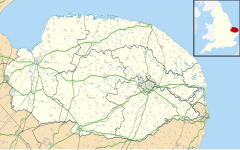Wickmere
| Wickmere | |
|---|---|
 The Village sign |
|
| Wickmere shown within Norfolk | |
| Area | 7.07 km2 (2.73 sq mi) |
| Population | 158 (parish, 2011 census) |
| • Density | 22/km2 (57/sq mi) |
| OS grid reference | TG1733 |
| • London | 133 miles (214 km) |
| Civil parish |
|
| District | |
| Shire county | |
| Region | |
| Country | England |
| Sovereign state | United Kingdom |
| Post town | NORWICH |
| Postcode district | NR11 |
| Dialling code | 01263 |
| Police | Norfolk |
| Fire | Norfolk |
| Ambulance | East of England |
| EU Parliament | East of England |
| UK Parliament | |
Wickmere is a village and a civil parish in the English county of Norfolk. The village is 18.9 miles (30.4 km) North of Norwich, 7.3 miles (11.7 km) south-south-west of Cromer and 132 miles (212 km) north-east of London. The nearest railway station is at Gunton for the Bittern Line which runs between Sheringham, Cromer and Norwich. The nearest airport is Norwich International Airport. The parish of Wickmere in the 2001 census, a population of 125, increasing to 158 at the 2011 Census. For the purposes of local government, the parish falls within the district of North Norfolk.
Wickmere gets its name from the old English meaning Lake by a dairy farm. The village is made up of a few cottages built to provide accommodation for the workers on the near-by Wolterton Estate, which was once the family seat of the younger brother of the Prime Minister, Robert Walpole. The parish has a long history that pe-dates the Norman Conquest
Over the years archaeological finds have proved that people have lived in the parish of Wickmere as far back as prehistoric times. These finds, made in 1991 take the form of prehistoric pot boiler. These flints represent the use of fire by the early inhabitants of the area for the purposes of heating water for cooking and washing.
Evidence has also been uncovered of activity here in the Bronze age with the find of Pieces of casting waste which might provide evidence for a metal working site in Wickmere. Discoveries by metal detectors of a copper alloy adza and an axe head, along with pottery shreds are more evidence of activity here in this period.
...
Wikipedia

